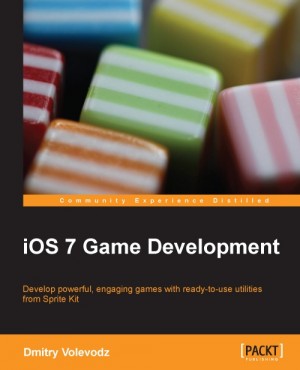iOS7 is Apple’s latest update to their mobile OS at the time of this writing. With it came huge changes for consumers and developers. Namely ‘flat’ design came about and the entire iOS interface was redesigned with new visuals. The change meant new features for developers too such as SpriteKit – the new 2D game development framework.
iOS7 Game Development by Dmitry Volevodz from Packt Publishing demonstrates how to create an endless runner using the new SpriteKit framework
SpriteKit seems simple enough to get into simple apps into the Appstore. One of the issues with mobile game development is that it heavily relies on 3rd party libraries and software. SpriteKit is Apple’s own first party solution for 2D development so that likely means that it will receive full update support moving forward to iOS8 and beyond. 3rd party solutions can never really garuntee that.
The book starts off explaining various iOS7 update changes and features then delves into SpriteKit. Inside SpriteKit is very similar to other 2D game development frameworks such as Construct 2. Scenes and Nodes are the primary elements of the framework and the books describes the different types of Nodes well and how to implement them.
The book shows you how to put a background image into the project and place a player sprite in the game. The background receives code to make it infinitely loop as the player moves with procedural logic meaning that it’s very effective and efficient. The book does well to describe and demonstrate code fragments. Anchoring nodes, the node heirarchy, text labels, touch input, gestures, and accelerometer controls are explained as well and shows how you can apply them to the endless runner example. There isn’t much in the way of screenshots within SpriteKit but it’s fairly clear how to tie everything together along with the code.
However I must express my personal opinion. Note this is irrelevant to the author or the book itself. It directly applies to Apple and iOS. The code is just completely ugly. The syntax just makes self – documented code nearly impossible. So bonus points to the author for explaining the code quite well. I am not sure if I myself can still get behind native iOS & Apple development just yet especially for $99 it costs to be a developer. Per year.
Physics and Animation also get covered. Sadly physics isn’t really too used in the endless runner example but the acceleration and gravity for jumping is easy enough to get your feet wet. Sound and parallax backgrounds get the code routine too.
The most impressive part to me about the SpriteKit framework is the particle system. It really seems powerful and highly configurable. Particle systems can be found in a lot of frameworks but the physics integration seems pretty cool. The book demonstrates some effects like a jet pack and shield that do a good job of showing off the particle system.
iOS7 Game Development
Pros
- Easy-to-follow book for only $15 ebook (great value)
- Detailed enough to understand the benefits of iOS7’s new SpriteKit framework
- Code itself is messy, but at Apple’s fault. The author does a good job explaining code fragments
- Code download available
- Well done endless runner example
Cons
- Somewhat short book
- Game logic itself isn’t too detailed
Note that personally I do feel that there are other frameworks probably way more effective than SpriteKit such as Construct 2.
Conclusion: Recommended
Who for: If you’re interested in getting you feet wet with native iOS7 development using Apple’s own new 2D game development tool.
Requirements: Mac OSX and the latest XCode

